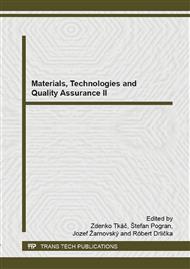p.19
p.27
p.35
p.43
p.53
p.61
p.67
p.75
p.83
Effect of Temperature on Dynamic Viscosity and Activation Energy of Milk and Acidophilus Milk
Abstract:
This article is focused on temperature dependencies of rheological parameters as the dynamic viscosity and activation energy of milk and acidophilus milk. Viscosity measurement was performed using a single-spindle viscometer. The relations of dynamic viscosity and activation energy in the temperature range 5–25 oC for milk and acidophilus milk were measured. The relations of all physical parameters of milk to temperature showed the influence of relative fat content. The effect of temperature on milk and acidophilus milk parameters is shown in Fig. 1–4. In the measured temperature interval, dynamic viscosities of milk ranged between 2.0 mPa.s and 1.3 mPa.s, and of acidophilus milk between 443.4 mPa.s and 244.1 mPa.s. Measured relations of dynamic viscosity for milk and acidophilus milk during temperature stabilisation had an exponential decreasing progress (Fig. 1–2), which is in accordance with Arrhenius equation. Temperature dependencies of activation energy are described by linear increasing functions (Fig. 3–4). Obtained values of activation energy were in the range 356.97–1267.70 J/mol for milk and in the range 615.94–2129.96 J/mol for acidophilus milk. The mathematical description of the dependencies is summarised by regression equations 2 and 3. Coefficients of regression equations and coefficients of determination approximately in the range 0.984–0.999 are presented in Table 1.
Info:
Periodical:
Pages:
53-59
Citation:
Online since:
December 2014
Authors:
Keywords:
Price:
Сopyright:
© 2014 Trans Tech Publications Ltd. All Rights Reserved
Share:
Citation:


